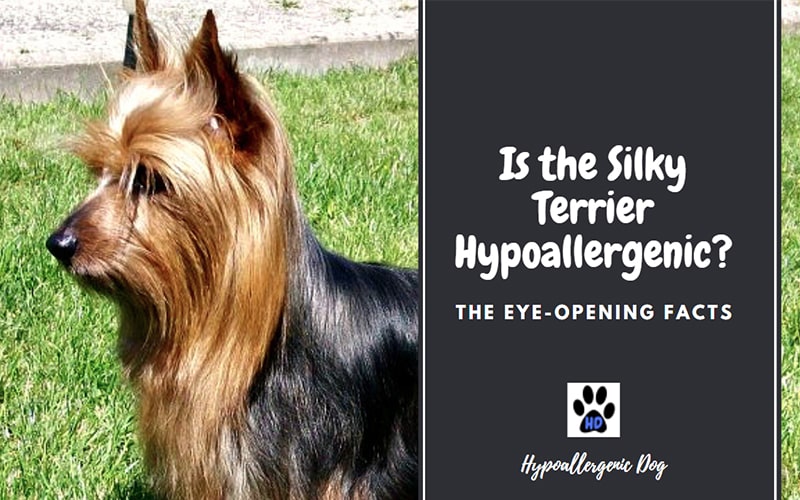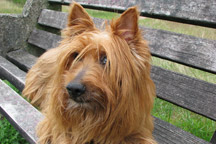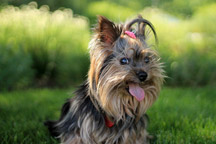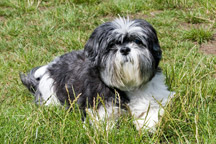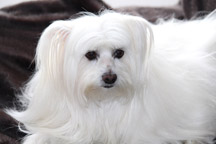Are Silky Terriers Hypoallergenic Dogs?
Yes! With a distinctive silky and smooth coat that doesn’t shed, he’s the ultimate allergy-friendly pooch!
The Hypoallergenic Silky Terrier
All that hair, right?
It’s true that the wonderful coat of the Silky Terrier is possibly his most defining characteristic. Although, this feature can put off many prospective pet parents, thinking that it’s bound to send them into a sneezing frenzy.
Trust me, it won’t!
Despite having fur that nearly reaches all the way down to the floor, this pooch is as proud and protective of its fur coat as a high-class socialite lady. Or Kanye West.
The Silky Terrier sheds a surprisingly low amount of hair. In fact, it holds onto it so well that it requires extensive grooming to prevent matting and tangles — hence, it’s not a pooch for those people who love a low-maintenance doggie.
Furthermore, with few skin issues, these adorable pooches produce little dander — which is equally as liable as fur for inducing allergy symptoms.
Are Silky Terrier Hypoallergenic Dogs? Contents
About the Silky Terrier
Characteristics of the Silky Terrier
Silky Terrier Temperament
Silky Terrier Training and Exercise
Silky Terrier Health Problems
Conclusion
Silky Terrier FAQs
Silky Terrier Fact Summary

About the Silky Terrier
It doesn’t take a canine breeding expert to see that this pooch has a Yorkshire Terrier background!
In the 19th-century, Australian dog fanciers crossed the Aussie Terrier (itself a descendent of the Yorkie) with purebred Yorkshire Terriers — leading to this cute looking pooch.
Originally, it was known as the Sydney Silky (as that’s where it was primarily bred). While its ancestors were mainly working dogs — for hunting rats, mice and snakes — the Silky was a much more homely animal — bred as a companion.
This pooch was recognized by the AKC in 1959 — although the Americans, for some reason, dropped the national identity and entered it into their books as just the Silky Terrier.
Today, many canine enthusiasts struggle to differentiate between the Silky and the Yorkie.
But, I’ll divulge the secrets so you can impress your friends (or bore them if they’re not interested in doggies).
- Silky Terriers have almond-shaped eyes — Yorkie’s are round.
- The Silky is larger than the Yorkshire Terrier.
- The muzzle on a Silky Terrier is longer than the Yorkie’s and has a pronounced wedge shape.
Characteristics of the Silky Terrier
You can’t miss their coat!
The typically blue and tan fur is straight (when brushed!) and is glossy and silky to the touch. It acts and feels exactly the same as human hair. Ideally, this should be left to grow to its full floor length — although some owners do opt for a puppy cut. Although — for me — this ruins its distinctive appearance.
Bear in mind, though, that grooming is essential — both combing and shampooing.
Colors of the Silky include (all mixed with tan):
- Steel blue
- Pigeon blue
- Stone blue
- Slate blue
Their inquisitive-looking, wedge-shaped head has a plume of hair — usually parted by pet parents down the middle. This is flanked by their V-shaped, erect ears — giving the Silky a countenance of constantly being on high alert.
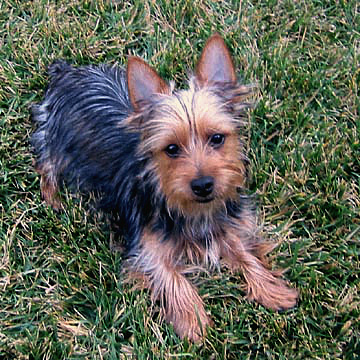
Silky Terrier Temperament
In many ways, the Silky Terrier is full of contradictions!
Gorgeously cute, yet not overly sculpted — boisterous, but not yappy — tiny, yet far from fragile.
See what I mean?
Similar Dog Breeds To Silky Terriers
If you can manage to calm these fur babies down for five minutes — you’ll find that they’re affectionate to a fault, showering you with love and attention. Just remember
that this can lead to jealousy — especially if you dare to stroke another doggie!
For this reason, it’s best not to introduce a Silky to a household that already has four-legged friends — they will not mix well. Furthermore, many owners report issues bringing up two male Silky puppies together.
While not aggressive, if a stranger enters your home, these poochies will bark — a lot! They’re establishing that they’re the boss, and that this ‘intruder’ shouldn’t make him or herself too much at home.
Around kids, they’re great — and they love to join in games. However, just be careful with younger children — although Silkies are tough, they’re not indestructible toys!
Silky Terrier Training and Exercise
Ranked as the 37th most intelligent dog breed, they’re not difficult to train — and with this pooch more than many others — early instruction is essential.
From day one, you need to establish the ground rules with your Silky — and — most importantly — stick to them! It’s tempting to allow your cute and lovable pooch to get away with the odd piece of naughtiness now and again — but give the Silky an inch and he’ll take a mile!
While suitable for apartment life, they need pet parents who are willing to dedicate the time to exercise and play — otherwise, they will become bored, vocal, and destructive.
They love games of fetch — but ensure that you let them off the leash in an area with solid and extensive boundaries. With a high prey drive, the Silky loves nothing more than chasing (and killing) smaller mammals. No fence, and you’ll see your pooch disappearing off into the distance.
These doggies enjoy — and perform exceptionally well in — competitive exercise contests, such as flyball and agility.
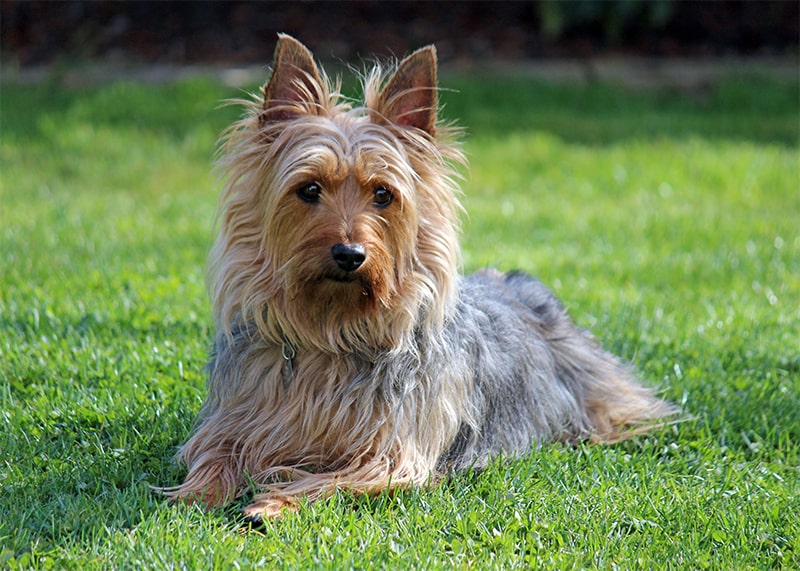
Silky Terrier Health Problems
In general, the Silky Terrier has few health problems, and usually enjoys a happy lifespan of around 13-15 years.
That said, there are a few conditions which responsible pet parents should keep a lookout for:
You should also monitor your Silky’s eyes.
They can have a propensity to weep — causing discomfort and matting their fur on the underside of the lower lid. Dabbing a little warm water on a sponge — in conjunction with veterinarian-approved soap — can remove any sticky residue.
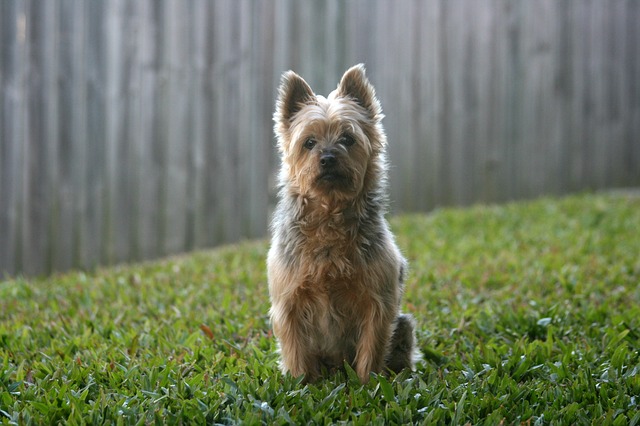
Conclusion
These vivacious, highly alert, and insatiably lovable dogs are the perfect family companions.
Just remember — you need the energy and matching desire to play and exercise!
And, its glossy and long coat hardly ever sheds — meaning one ideal hypoallergenic pooch!
Silky Terrier FAQs
Do Silky Terriers Have Hair or Fur?
If you want to be scientific — they’re one and the same.
The chemical structure of hair and fur is identical — the only difference is in word usage — humans have hair, animals have fur.
However, the Silky’s coat is so smooth and fine that it feels the same as the hair sitting on the top of your head right now (well, unless you’re bald or wearing a toupee).
Do Silky Terriers Shed?
These pooches — like every single canine on the planet — shed hair.
However, apart from some seasonal loss in spring and fall, for the rest of the year, the Silky Terrier shedding rate is very low. This makes them wonderful hypoallergenic dogs.
What’s the Silky Terrier Weight?
A typical Australian Silky Terrier weight is around 10 pounds.
How Big Is a Silky Terrier?
The Silky Terrier size is between 9 and 10 inches.
Are Silky Terriers Hypoallergenic?
The Silky Terrier Australian dog sheds little hair, drops little dander, and doesn’t slobber or drool — making them ideal hypoallergenic dogs.
Silky Terrier Fact Summary
| Breed | Silky Terrier |
| Other Names? | Aussie Silky Terrier and the Australian Silky Terrier. |
| Height | 9-10 inches (23-25.4 cm) |
| Weight | 10-11 pounds (4.5-5 kg) |
| Lifespan | 13-15 years |
| Temperament | Feisty, alert, brave, inquisitive, affectionate, lovable, jealous, and keen.
|
| Colors | Tan mixed with steel blue, pigeon blue, stone blue, and slate blue. |
| Coat | Glossy, smooth, long, and silky — almost human-hair-like. |
| How much grooming? | Needs brushing through at least twice a week. Additionally, shampooing is required to keep the coat shiny and in top form. |
| How much shedding? | Low — typically only noticed in spring and fall. |
| Dander levels | Low |
| Saliva – Do they Drool or Lick much? | Low – not a breed that’s known for its drool or slobber |
| Energy levels | High energy — the prospective pet parent should share this desire for exercise. |
| How much exercise do they need? | At least one 20-minute walk per day combined with some indoor games. |
| Health problems | Generally healthy — although known to suffer from luxating patellas, Legg-Perthes disease, Cushing’s syndrome, and diabetes. |
| Good for an apartment? | Excellent — but only when given daily outdoor exercise too. |
| Suitable for kids? | Good — be careful around small children as these pooches aren’t indestructible. |
| How much do they bark? | Occasionally when left alone or when highly excited or disturbed. |
| Can they be left alone? | Not really — only for short periods. |
| Intelligent? | Moderate to high. |
| Trainable? | Moderate to good – ensure from a puppy you lay down the ground rules. |
| How popular as a pet? | Fairly — ranked 112th out of 195 breeds by the AKC. Additionally, the Silky Terrier Hypoallergenic nature makes them popular with allergy sufferers. |

